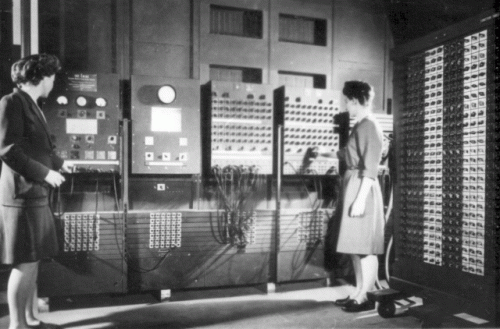Jean Bartik
|
Jean Bartik Jean Bartik born Dec. 27, 1924 As one of the Army’s first programmers, Jean Bartik (born Elizabeth Jean Jennings) was also one of the first women in the field of computer science. Bartik was born in Missouri on a farm. She was athletic and grew up playing softball, becoming a local star. When she entered Northwest Missouri State Teachers College, she was encouraged to major in physical education, but her interests in math and physics led her to major in mathematics. During Bartik’s first year of college the Japenese bombed Pearl Harbor, and Bartik found herself taking classes with sailors and other draftees. According to NASA’s published background on Bartik, she was the only woman in most of her math and physics classes. When she graduated with a bachelor’s degree in 1944, Bartik left Missouri to work for U.S. Army Ordnance at the University of Pennsylvania. She was assigned to be a “computer” (people, mostly women, who used desk calculators to perform critical computations such as the firing tables for guns). At the time, these women received a subprofessional rating from the Army and were paid $2,000 per year. In 1945, Bartik applied and was selected as a programmer on the ENIAC (Electronic Numerical Integrator and Calculator), one of the earliest electronic, digital computers. The ENIAC could perform in 30 seconds a calculation that took Bartik and her fellow “computers” approximately 20 hours. Today’s supercomputers could perform the same calculation in a few microseconds. Bartik and her peers hardwired the computer separately for each calculation by setting thousands of switches and altering hundreds of cable connections. There were no manuals and no instruction set, and at first, no visual representation—the women were not allowed to see the 30-ton colossus until they received security clearance, so design diagrams sufficed instead. In 1947, Bartik assembled and trained the team that converted the ENIAC to a stored program machine. She also helped to write the program code that was used. The code for the ENIAC was not like today’s program code; it was instead a set of basic instructions (add, multiply, etc.). Previously these functions been “programmed” by altering cable connections. Now, they would be permanently hardwired into the computer. Even so, the work performed by Bartik and her group represented a step toward the programming languages that would be written a few years later. Working for Eckert-Mauchly Computer, Bartik later programmed the BINAC (Binary Automatic Computer) and performed logical design for the UNIVAC I (Universal Automatic Computer), including designing a CRT (cathode-ray tube)-based memory for the machine. Today she is retired but is still a participant in women’s technology groups. In 1997 Bartik was inducted into the WITI (Women in Technology International) Hall of Fame.
Jean Bartik is on the left in the photograph with the ENIAC computer
|
|










